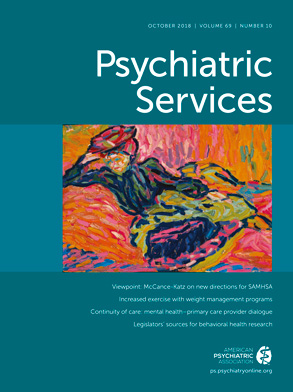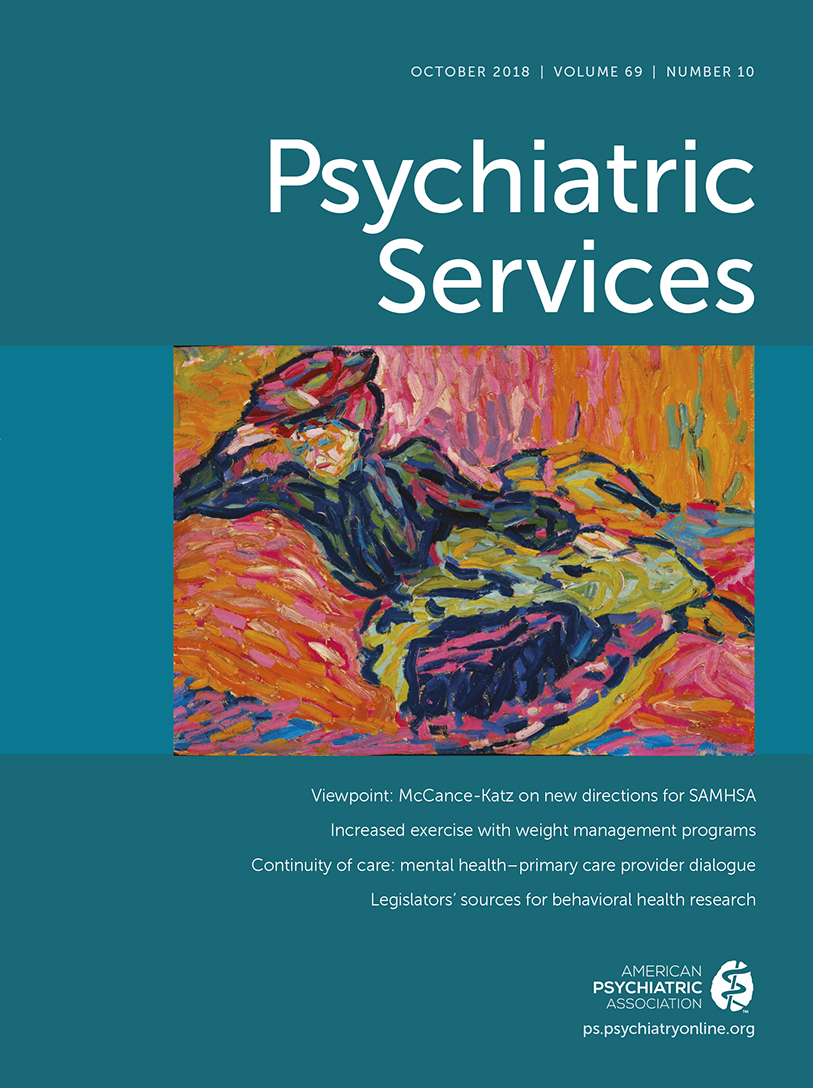There are 7,383 state legislators in the United States, and their decisions have tremendous influence on mental health and substance use outcomes (hereafter referred to as behavioral health). For example, through decisions related to insurance coverage and workforce development, legislators influence access to behavioral health services (
1). Through allocation of tax revenue (e.g., by funding supportive housing) and regulation of behavior (e.g., by permitting recreational marijuana use), legislators influence the social determinants of behavioral health (
2). For these reasons, state legislators have been identified as an important audience to target when disseminating behavioral health research findings (
3,
4). However, as demonstrated by a 2016 systematic review (
4), there is little empirical guidance about how to most effectively disseminate behavioral health research to state legislators, or to policymakers more broadly.
At least three important knowledge gaps exist. First, little is known about where legislators seek behavioral health research when making policy decisions. Typically, legislators lack in-depth expertise on specific issues (e.g., behavioral health), and they seek out research on issues as they arise on policy agendas (
5). Universities are major producers of behavioral health research and are largely perceived as credible (
6), but studies suggest that legislators might not perceive universities as possessing information that is relevant to the policy decisions they face (
7). An understanding of where legislators turn for behavior health research can inform researchers’ dissemination strategies.
Second, it is not clear which features of behavioral health research are most important to legislators. Such features might include the format in which findings are presented (e.g., a concise policy brief) and the information provided about implications (e.g., budget impact). A 2012 survey found that state legislators who prioritized behavioral health issues had stronger opinions about features of research than legislators who did not prioritize these issues (
6). Although this work and other studies (
5) indicate legislators’ preferences for research in general, little is known about their preferences for behavioral health research in particular. This distinction is important because misconceptions about behavioral health issues, and stigma toward people with behavioral health conditions, are pervasive (
8,
9). Furthermore, information about legislators’ specific preferences for behavioral health research can provide the most concrete guidance for behavioral health advocates as they attempt to inform and influence policy makers.
Third, studies of legislators’ preferences for disseminated research have not examined differences by political party affiliation. Polarization is increasing in state legislatures (
10), and it is plausible that Democrat and Republican legislators seek behavioral health research evidence from different sources and value different features of research. Such differences could have important implications because opinions about behavioral health issues, and policy solutions to address them, vary by political party. Compared with Democrats, Republicans generally report more stigma toward people with behavioral health conditions and are also less supportive of government spending on behavioral health (
8,
9). Information about how Democrat and Republican legislators’ preferences for behavioral health research differ could inform dissemination strategies (e.g., tailored materials based on party affiliation).
This exploratory study was conducted to inform dissemination strategies that aim to enhance the use of behavioral health research by state legislators. The objectives were to determine where state legislators seek behavioral health research evidence, identify the features of behavioral health research that are most important to legislators, and assess differences in these research-seeking practices and dissemination preferences between Democrats and Republicans.
Methods
A cross-sectional, multimodal survey of state legislators using mail, e-mail, and telephone was conducted between March and September 2017. Complete details about the recruitment process and sample frame are provided in the published study protocol (
11). In short, the survey was sent to a state-stratified, random sample of 2,902 legislators who were in office as of January 15, 2017. Each legislator was mailed an invitation to complete the survey online, was mailed two paper versions of the survey, was called up to 15 times, and sent 10 e-mail invitations to complete the survey online.
The survey was completed by 475 legislators. The response rate was 16.4%, which is acceptable for state legislators and higher than the response rates for recent surveys of legislators (
12,
13). Respondents were statistically significantly more likely than nonrespondents to be a Democrat (N=232, 49%, versus N=1,029, 42%; p=.001), to be female (N=155, 33%, versus N=559, 23%; p<.001), and to be from the Midwest (N=145, 31%, versus N=545, 23%; p<.001). To adjust for these differences, a poststratification approach was used to calculate and apply sample nonresponse weights that accounted for political party, gender, and geographic region. Approval was obtained from the Drexel University Institutional Review Board.
Legislators’ primary sources of behavioral health research and dissemination preferences were assessed by using items adapted from Bogenschneider and Corbett’s (
5) studies of state legislators. The legislators’ sources of behavioral health research were assessed by asking “who they would turn to” if they “were going to seek out mental health/substance abuse research to make a policy decision” and instructing them to select up to three sources from a list of nine options. The features of behavioral health research that legislators perceived as most important were assessed by asking legislators to rate “how important would it be” for “mental health/substance abuse research [they receive]” to have seven features on a 5-point Likert scale, from 1 (not important) to 5 (extremely important). Ratings of 1, 2, and 3 were coded as not very important and ratings of 4 and 5 were coded as very important.
Political party affiliation, the primary independent variable, was obtained from the National Conference of State Legislatures (NCSL). Information on gender was also obtained from NCSL, and information on highest level of education was obtained through the survey and was coded as college degree or less or postgraduate degree or more.
Descriptive statistics characterized the sample and chi-square tests were used to examine differences between Democrats and Republicans. We did not include legislators who were registered as Independents or had no party affiliation in the comparisons because these legislators accounted for only 2% of the sample. Multivariate logistic regression was used to produce adjusted odds ratios (AORs) of a legislator selecting each source of research and rating each feature of research as very important given their political party, controlling for gender and education.
Results
When all legislators were analyzed together, behavioral health advocacy organizations (53%), legislative staff (51%), and state behavioral health agencies (48%) were most frequently identified as sources legislators turn to for behavioral research (
Table 1). However, advocacy organizations were identified significantly more frequently by Democrats than Republicans (65% versus 40%, AOR=2.25). Only 27% of legislators identified universities as a source they would turn to for behavioral health research. The proportion of legislators who identified universities as a source they would turn to for behavioral health research was significantly higher among Democrats than Republicans (34% versus 19%, AOR=1.79). Industry was chosen least frequently as a source of behavioral research (11%), but the proportion choosing industry was significantly lower among Democrats than Republicans (6% versus 16%, AOR=.33).
Three features of behavioral health research—inclusion of data on budget impact, cost-effectiveness, and brief, concise presentation—were each rated as very important by 82% of legislators. However, the proportion of legislators who identified budget impact data and cost-effectiveness data as very important was significantly lower among Democrats than Republicans (77% versus 87%, AOR=.45, and 76% versus 89%, AOR=.30, respectively). Political feasibility was identified least frequently as a very important feature of behavioral health research by both Democrats (51%) and Republicans (51%).
Discussion
This study characterized state legislators’ practices for seeking out behavioral health research and dissemination preferences and found that some of these varied significantly between Democrats and Republicans. Democrats most frequently identified advocacy organizations as a source they turn to for behavioral health research, and Republicans most frequently identified state behavioral health agencies. Among both Democrats and Republicans, legislative staff were identified second most frequently. This finding is consistent with prior studies that indicate that staffers are an important audience to target when disseminating research to legislators (
5) and with evidence suggesting that intermediary organizations play a critical role in translating health research into policy (
14).
Universities were not a primary source from which legislators reported seeking behavioral health research, especially among Republicans (19%). In fact, Republican legislators were almost as likely to identify industry as a source of behavioral health research (16%) as they were to identify universities. These findings are consistent with prior research that suggests that many legislators perceive the evidence produced and possessed by university researchers as lacking relevance to real-world policy decisions (
5,
7). However, these findings contrast with the results of a 2012 survey of state legislators, which found that universities were rated as the most credible source of research (
6). Considered together, these findings support the notion that legislators seek research from sources that are perceived as having information that is most relevant to the policy decisions they face, even if these sources are not perceived as most credible (
7). This underscores the importance of university-based behavioral health researchers investigating policy-relevant questions. These findings also suggest that strategies supporting the dissemination of research to trusted intermediaries may be particularly impactful, given that legislators turn to these sources when making policy decisions.
Data on budget impact and cost-effectiveness were identified most frequently as very important features of behavioral health research. This finding highlights the value of conducting economic evaluations of behavioral health interventions that are relevant to contemporary legislative decisions. However, there is a paucity of such studies. For example, a 2016 review of economic evaluations of opioid use disorder interventions found ample evidence about the cost-effectiveness of methadone maintenance treatment. However, the review found relatively few evaluations of the economic impact of opioid interventions that are being considered in state legislatures (e.g., increased access to buprenorphine and naloxone) (
15). The finding that data on budget impact was frequently rated as very important signals the need to conduct economic evaluations of behavioral health interventions from narrow state government perspectives (e.g., Medicaid and criminal justice) in addition to broader societal perspectives.
Inclusion of economic evaluation data could be especially important when disseminating behavioral health research to Republican legislators. Republicans were significantly more likely than Democrats to identify cost-effectiveness and budget impact data as very important. Furthermore, public opinion surveys indicate that Republicans are less supportive of spending on behavioral health services than Democrats (
8,
9). Thus economic evaluations that demonstrate cost savings could foster support among Republican legislators for laws that increase access to behavioral health services.
Our study had limitations. Although a response rate of 16% is higher than response rates of recent legislator surveys (
12,
13), it is low compared with standards for patient and provider surveys. Information about the political party, gender, and geographic region of nonrespondents allowed us to calculate and apply sample nonresponse weights. This increases confidence that the survey results approximate the behavioral health research use practices and dissemination preferences of the larger population of state legislators. Nevertheless it is plausible that legislators who completed the survey were systematically different across these domains from those who did not.
Conclusions
Entities that want behavioral health research to reach and influence state legislators should disseminate findings to diverse sources—specifically legislative staff, behavioral health advocacy organizations, and state behavioral health agencies. Dissemination materials should be concise and, when possible, contain information about cost-effectiveness and budget impact.

